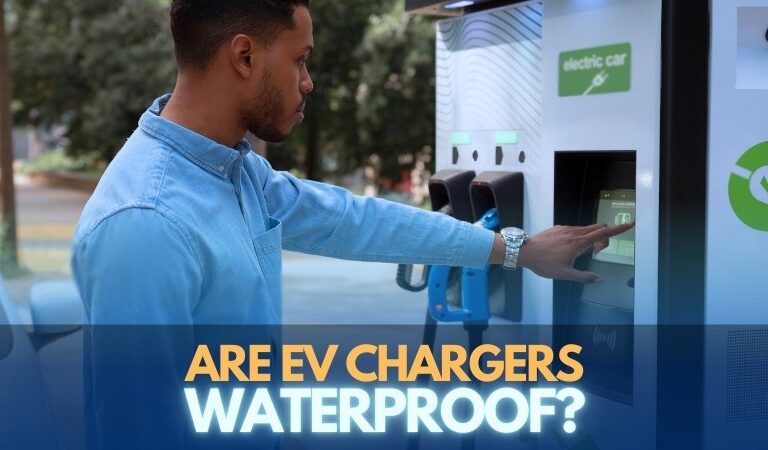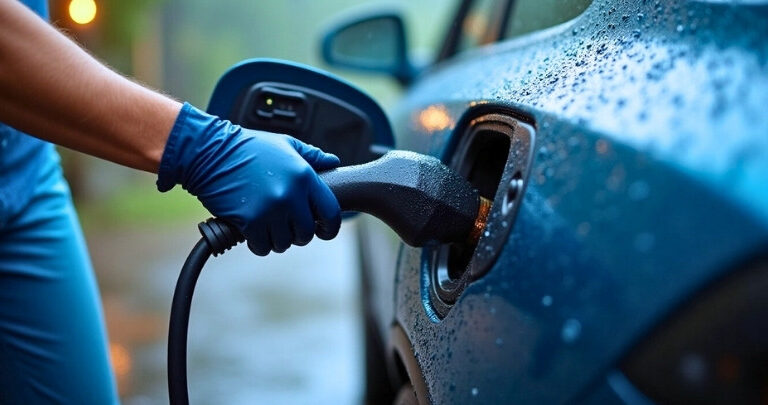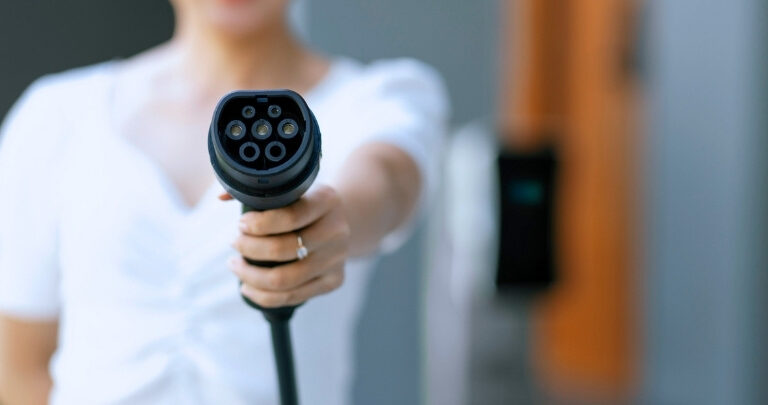EV vehicles are becoming more popular as a sustainable and efficient alternative to traditional cars nowadays. With the rise in electric vehicle ownership, many people are curious about the best ways to charge their vehicles. This leads to a common question: “Are EV chargers waterproof?”
Yes, the EV chargers are waterproof and built to withstand rain and other weather conditions. They feature sealed designs, GFCIs, and insulated connectors to ensure safe, reliable charging even in wet environments. These safety features protect both the charger and its users from water-related electrical hazards.
In the rest of this article, we’ll explore how EV chargers are engineered for outdoor use and what you should know to charge safely in any weather.
Are EV Chargers Waterproof?
Yes, EV chargers are waterproof. These chargers are used to power electric vehicles and are often placed outdoors. Since they stay outside, people often wonder how they handle rain or water. If you’re curious about what makes them waterproof, keep reading to find out more.

Strong Outer Case
EV chargers come with a strong outer cover that keeps water from getting inside. This cover is made from special materials that do not let water pass through easily. It also protects the charger from dust and dirt. Even during heavy rain, the inside of the charger stays dry. This helps the charger work safely without any problems.
Sealed Connections
All the parts where wires and cables connect are tightly sealed. These seals make sure that no water can enter through the small gaps. Even if water splashes on them, it won’t go inside. This is very important because wet wires can cause short circuits. The seals keep everything safe and dry.
Built for Weather
EV chargers are made to work in all kinds of weather—hot, cold, rainy, or windy. They are tested to make sure they can handle these conditions without breaking. So even if you leave the charger outside, it keeps working fine. You don’t have to worry every time the weather changes. It’s made to stay strong outdoors.
Safety Features
These chargers have built-in safety tools to protect users. One important part is called a GFCI, which stops electricity if something goes wrong. This helps prevent shocks, especially in wet conditions. The charger also checks itself for problems before it starts working. These safety steps keep both people and vehicles safe.
Special Charging Plugs
The plugs that connect to the car are also made to stay dry. They are covered in a way that keeps out water even if it’s raining. These plugs are easy to use and very safe. When you plug in your car, water won’t get into the charging port. This helps the charging process stay smooth and safe.
Tested for Safety
Before being sold, EV chargers go through many tests. These tests check if water can get inside and if the charger still works after rain or splashes. Only the chargers that pass these tests are allowed in the market. This gives users peace of mind. You can trust that the charger will work safely in wet weather.
Waterproof vs. Water-Resistant EV Chargers: What’s the Difference?
When choosing an EV charger, it’s important to know whether it’s waterproof or just water-resistant. These terms might sound similar, but they mean different things. Here’s a simple table to help you understand the key differences:
| Feature/Aspect | Waterproof EV Chargers | Water-Resistant EV Chargers |
| Level of Protection | Complete protection from water | Limited protection against light moisture or splashes |
| Suitable for Heavy Rain | Yes | Not recommended |
| Can Be Submerged | Often for short periods (based on rating) | No |
| Outdoor Use | Ideal for all weather | Only in light rain or covered areas |
| Sealed Design | Fully sealed against water entry | Partially sealed, may allow moisture over time |
| Safety in Wet Conditions | Very high | Moderate |
| Typical IP Rating | IP66, IP67, or higher | IP44 to IP55 |
| Lifespan in Wet Areas | Longer due to full protection | Shorter if exposed often to wet conditions |
| Maintenance Needs | Low | Higher needs more frequent checks |
| Best Use Case | Any outdoor setting | Mild environments or indoor garages |
What to Do If Water Enters the EV Charger Charging Port?
Water getting into the EV charger port can be a real problem, especially during rainy days or when the cover isn’t closed well. It might cause trouble with charging or even damage parts. Acting fast and safely is the best way to handle it. Here are some easy strategies for handling this situation.

Stop Charging Right Away
The first thing to do is stop charging immediately. Unplug the charger from the car and the power source. This lowers the chance of shocks or damage. Never touch wet parts while anything is still plugged in. Make sure everything is off before doing anything else.
Check for Water
Take a close look at the charging port to see if there’s any water inside. Use a flashlight for a better view. Even a little bit of water can be risky. Keep the charger unplugged until you’re sure it’s dry. Using it while wet can cause more problems.
Dry the Area
Use a soft, dry cloth or tissue to wipe the area around the port gently. Let it air dry for some time before trying to charge again. Don’t use a hair dryer or blower, as it might push water deeper. If it’s sunny, placing it in the open air can help. Make sure it feels completely dry to the touch.
Avoid Turning It On
Leave the charger and the car turned off while drying the port. Powering it on too soon can cause a short circuit or damage. It’s safer to wait a little longer and double-check. Being careful now can save you from repairs later. Only start charging when you’re confident it’s safe.
Get Help If Needed
If the port looks damaged or isn’t working after drying, it’s best to ask an expert. You can contact your car service center or even reach out to support from trusted providers like Crack Platoon EV Charging Solution for proper guidance. They can check the charger, make sure it’s safe, and tell you what to do next. Don’t try to fix any electrical parts yourself, as that can be risky. Getting the right help at the right time can prevent bigger problems later.
Prevent It Next Time
Always close the port cover properly after charging. Try to use the charger under a roof during bad weather. You can also use waterproof covers for extra safety. A few small steps can stop water from getting in. Keeping the charger dry will make it last longer.
Can Cold, Wet Weather Reduce the Charging Efficiency of Your EV Charger?
Yes, cold, wet weather can reduce the charging efficiency of your EV charger. Low temperatures make the battery work slower than usual. This slows down charging and reduces how much energy the battery can hold. Wet conditions can also cause trouble by allowing electricity to move where it shouldn’t.
Cold air and moisture together can make it harder for your EV to charge quickly and safely. When talking about EV charging speed factors, weather is one of the most important things to think about. Rain or snow can damage charging parts or lower how well they work. This means your EV might take longer to charge in these conditions.
To keep charging smoothly, try using your charger in dry, covered areas whenever possible. Avoid charging outside during storms or freezing weather. Always check that the charging port is dry before plugging in the cable. Taking small steps like these can make a big difference.
How Often Should You Inspect Your Outdoor EV Charger?
You should check your outdoor EV charger regularly to keep it working safely and properly. It stays outside, so the weather can affect it. Rain, dust, or heat might cause small problems that grow bigger over time. A quick look once a week helps catch issues early.
Every month, do a closer inspection to make sure everything looks good and clean. Check the cables, plugs, and cover for any damage or cracks. If anything feels loose or looks burned, stop using it and call for help. Keeping it clean and safe helps it last much longer.
After heavy rain or storms, it’s smart to give your charger another quick check. Water and electricity don’t mix, so better to be sure. Look for signs of rust, dirt, or water inside the charging area. A dry and clean charger is safer and works better every time.
At least once a year, have a professional check the charger for deeper problems you might miss. They know how to test things inside and fix small issues. This helps prevent big repairs and keeps charging fast and safely. A little care now saves trouble later and keeps your EV ready to go.
What to Watch for During Regular Charging Checks?
Charging your electric vehicle should be simple and safe, but it’s still a good idea to check things regularly. These checks don’t take long and help you avoid future problems. Even small signs can mean something is wrong with the charger. Look below to see what things you should watch out for during regular charging checks.

Cable Condition
Check the charging cable for cuts, cracks, or bends that don’t look normal. Damaged cables can lead to poor charging or even sparks. Make sure the cable feels strong and smooth when you touch it. Don’t use the charger if the wire feels hot. Replace the cable if it shows any signs of wear.
Plug and Socket
Look at the plug and socket where the charger connects to the car. They should not look burned, rusty, or dirty. A clean and tight connection helps your EV charge properly. Wiggly or loose plugs are a warning sign. If the plug doesn’t fit right, stop charging and check with a repair person.
Charger Box
The charger box should be closed tightly and free from cracks or damage. Water or bugs should not be able to get inside. Look for any blinking lights or warning signs on the box. These might tell you there’s a problem. If you see anything odd, it’s better to stop using it and get help.
Weather Effects
Look around the charger to see if water or mud is nearby. Water can make charging unsafe and damage the charger over time. Make sure the ground around it stays dry and clean. After storms or rain, check the area carefully. A clean space helps the charger stay in good shape.
Charging Speed
If your EV takes longer than usual to charge, that could mean something’s wrong. Charging should stay steady each time you plug in. One important part of checking EV battery health is noticing changes in charging speed or power levels. Keep track of how long charging normally takes. If it keeps slowing down, get it checked.
Heat and Smell
Touch the charger gently during use to check for too much heat. A little warmth is fine, but hot is not. Also, smell for any odd or burning odors. A strange smell could mean something is overheating. Stop charging right away if you notice anything like this.
Noises and Sounds
EV chargers should work quietly. Listen for buzzing, clicking, or popping sounds while it’s charging. These sounds can mean a loose wire or a broken part. It’s better to be safe than sorry. If it sounds wrong, unplug and check the charger.
Lights and Indicators
Most chargers have lights that show if they’re working properly. Learn what the normal light colors mean. If a light blinks or turns red, it could be a warning. Check the manual or look online for what each light means. Don’t ignore a light you haven’t seen before.
Commonly Asked Questions
When it comes to using EV chargers outdoors, many people have questions about safety, design, maintenance, and how waterproof these devices really are. Below are some helpful questions and answers to clear up common doubts and give you a better understanding.
Can You Leave an EV Charger Plugged in Outside All the Time?
Yes, you can leave a waterproof EV charger plugged in outdoors, but only if it is properly sealed and weather-rated. Chargers with a high IP rating are built to stay safe outside. Still, it’s smart to check it once in a while. Make sure no water or dirt has built up around the plug or socket.
Do EV Chargers Work During Heavy Rain?
Waterproof EV chargers are designed to work safely even when it’s raining heavily. The charger’s outer casing, seals, and protected connectors stop water from reaching the electrical parts. Charging in the rain is safe as long as the equipment is used correctly. Just don’t use a damaged charger in wet conditions.
What IP Rating Should an Outdoor EV Charger Have?
An outdoor EV charger should have an IP rating of at least IP66 to be considered highly waterproof. This means it is protected from strong water jets and dust. The higher the number, the better the protection. Always check the charger’s label or manual before installing it outside.
Is It Safe to Wash a Car While It’s Charging?
It’s not a good idea to wash your EV while it’s charging. Even if the charger is waterproof, water and soap can still reach the connectors. This might cause charging errors or small damage over time. Always unplug the charger before washing your car to be safe.
How Do I Know If My Charger is Truly Waterproof?
You can check the charger’s manual or look for the IP rating label on the charger itself. A good waterproof charger will clearly list this rating. If you can’t find it, contact the brand’s customer service. Avoid using it outdoors unless it’s clearly marked as waterproof.
What Happens If a Waterproof Charger Is Submerged?
Even though they are waterproof, most EV chargers are not meant to be fully submerged for long. If this happens, unplug it right away. Let it dry completely and have it checked by a professional. Submersion may damage the inside parts even if the outside looks fine.
Do Waterproof Chargers Work With All EV Models?
Waterproof chargers usually work with all EVs that support standard charging connectors. Always check that the plug type matches your car. The waterproof feature doesn’t affect compatibility. It just makes the charger safe for outdoor use.
Is There a Difference Between Indoor and Outdoor EV Chargers?
Yes, indoor chargers may not have the waterproof features that outdoor ones do. They may lack strong casing or weather sealing. Using an indoor charger outside can be dangerous. Always choose chargers made for outdoor use when placing them outside.
Final Thoughts
Electric vehicles are becoming a part of everyday life, and keeping them charged safely matters just as much as driving them. Whether it’s sunny, rainy, or snowy, your EV charger plays a big role in staying ready to go. That’s why it’s smart to understand how your charger handles outdoor conditions.
So, are EV chargers waterproof? Yes, they are built to stay safe and work well even when the weather turns bad. With sealed parts, strong covers, and smart safety features, these chargers are made to power your car without worry, even in the rain.
Still, it’s always a good idea to check your charger from time to time. A little care can keep it running smoothly and safely for years. Safe charging starts with smart habits.

